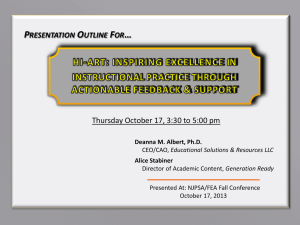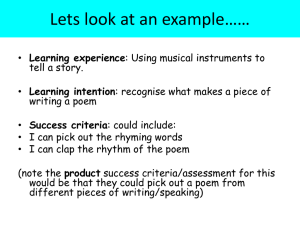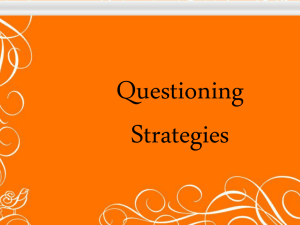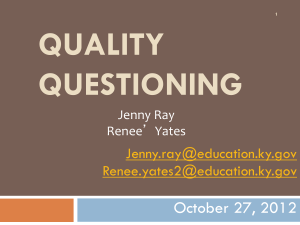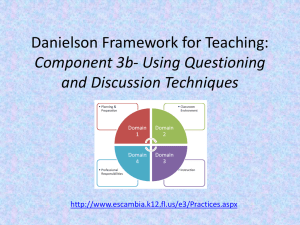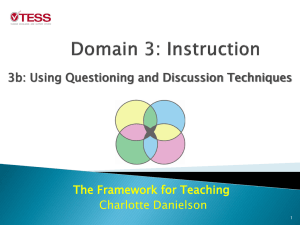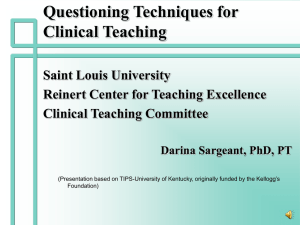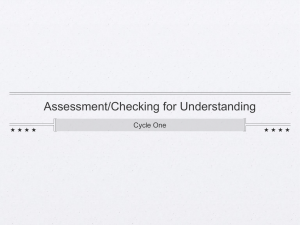November 29 ELA PowerPoint
advertisement
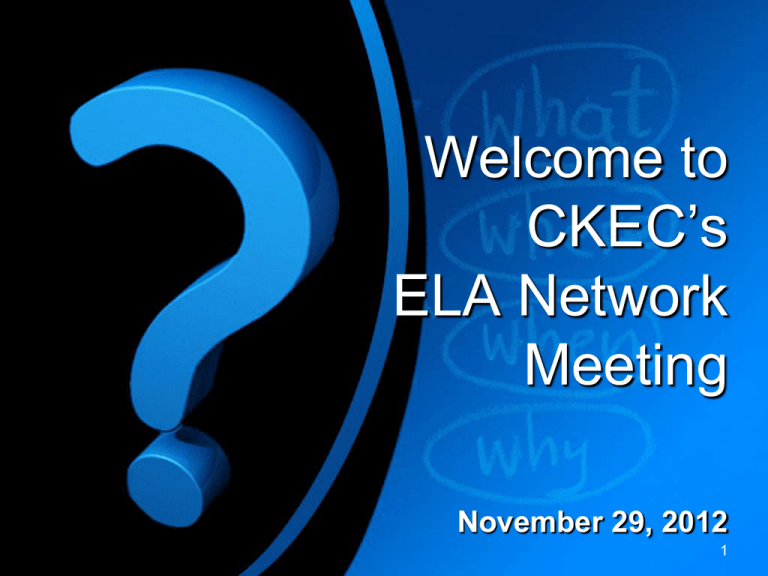
Welcome to CKEC’s ELA Network Meeting November 29, 2012 1 Our Facilitators • Les Burns, Program Chair of English Education, University of Kentucky • Kelly Clark, Secondary Literacy Consultant, KDE • Marci Haydon, Instructional Coach, Old Kentucky Home Middle School, Nelson County • Lisa King, Literacy Consultant, CKSEC • Kelly Philbeck, ELA Network Specialist, CKEC 2 Ask Questions & Engage Fully Open your mind to diverse views Utilize your learning Rule of two feet. Please silence cell phones. Return from breaks promptly. 2012-13 Teacher Leader Network Target I can use careful planning to improve instruction in order to become an effective teacher and leader. Learning Targets • I can use careful planning to improve instruction in order to be a more effective teacher and leader. • I can use careful planning to ask quality questions in classroom discussions. • I can use careful planning to write assessment questions congruent to my content standards. 5 A Few Housekeeping Items 6 Meeting Materials are on www.kellyphilbeck.com 7 R-Group Space • Introduction to R-Group Space • Explanation of Features • Consent Forms • If you are interested in joining R-Group Space, please turn your consent forms in to Kelly Philbeck by the end of our lunch break. 8 Text Complexity Raising Rigor in Reading • • • • Text Complexity Quantitative Measures Qualitative Measures Matching Readers to Texts • Close Reading 9 Today’s Theme: Questioning Instructional Toolkit KCAS CHETL TPGES LDC EFFECTIVE INSTRUCTION 10 Questioning as an Effective Instructional Tool Questioning: • Promotes effective classroom discussions, both formal and informal • Promotes higher order thinking and deeper understanding • Engages inquiry skills • Requires students to formulate higher order questions • Promotes mastery of standards/learning 11 targets Questioning and Discussion Techniques Presented by: Les Burns 12 Model Texts by Grade Level K-1 Stella Luna by Nell Cannon Read aloud to students Hanging with Fruit Bats Read aloud to students 2-3 A Field Trip to Remember Ostriches 4-5 Up to My Neck in Trouble The Bottlenose Dolphin 6-8 --Childhood --Shimmel Shine --Boar Out There and News Article --Ain’t I a Woman --How People Help Nature in Oil Spills 9-10 Everything Else Falls Away, Lee Intuition mind map and 2nd stanza Smith “Intuition” by Jewel 11-12 Jonathon Harker’s Journal, (Dracula “5 May” or Chapter 2) Gut Almighty 13 Using What’s There • Review the texts you are teaching, and identify: – What skills do my students have to learn/practice in order to understand and perform? – What techniques, concepts, or conventions (form, plot, sequence, dialogue, text cues, symbols, vocabulary, etc.) are present in the text in ways that make them worth highlighting? • How do the KCAS standards and learning targets 14 reflect these possible instructional goals? What Really Matters? (To Students) (A Note about Comprehension and Accountability Questions) • Generative Topics – (Thematic Statements are richer) • Essential Questions – Vehicles that drive teaching and learning tasks. • Offer rich ideas to frame inquiry, discussion, writing/thinking, and assessment. • Allow multiple “correct” responses supported by evidence from texts and real life. 15 Questions, Instruction, and Assessment • Scaffolding to support student success • Logical Sequencing • Positioning students are “primary knowers” • Empowering students to participate • Focusing instruction • Only assess what you actually taught! – Teaching means more than telling. Don’t forget modeling, practice, application, and discussion. (See CHETL) 16 “Levels” of Questioning Bloom’s Taxonomy 17 Bloom’s Taxonomy Re-Visited 18 Discussion Techniques • • • • • • • Lecture Recitation QAR (Question-Answer-Response) Socratic Seminar Literature Circle “Fish Bowl” Other? – What is the teacher’s role? 19 Discussion Techniques – What are the Teacher’s Roles? • “Lead Student” – (Facilitator, Coach, Referee, Judge, Moderator) – Rough-draft and finaldraft talk • Re-voice and Probe • Model • Prompt • Expand • Connect • Explain • Clarify 20 CHETL Connections • Learning Climate 1. Creates learning environments where students are active participants as individuals and as members of collaborative groups 2. Effectively allocates time for students to engage in hands-on experiences, discuss and process content and make meaningful connections • Assessment and Reflection 1. Uncovers students’ prior understanding of the concepts to be addressed and addresses students’ misconceptions/incomplete conceptions 2. Provides adequate modeling to make clear the expectations for quality performance 3. Allows students to use feedback to improve their work before a 21 grade is assigned CHETL Connections • Rigor and Engagement 1. Teacher orchestrates effective classroom discussions, questioning, and learning tasks that promote higher-order thinking skills. 2. Teacher provides meaningful learning opportunities for students. 3. Teacher challenges students to think deeply about problems and encourages/models a variety of approaches to a solution. 4. Teacher clarifies and shares with students learning intentions/targets and criteria for success. 22 CHETL Connections • Relevance 1. Teacher links concepts and key ideas to students’ prior experiences and understandings , uses multiple representations, examples and explanations. Students’ funds of knowledge. 2. Teacher incorporates student experiences, interests and reallife situations in instruction. 3. Students must identify these for themselves, not have them assumed or dictated by teachers. 4. Student develops descriptions, explanation, predictions, and models using evidence. 23 Questioning Workshop 9:30-10:30 24 Model Texts by Grade Level K-1 Stella Luna by Nell Cannon Read aloud to students Hanging with Fruit Bats Read aloud to students 2-3 A Field Trip to Remember Ostriches 4-5 Up to My Neck in Trouble The Bottlenose Dolphin 6-8 --Childhood --Shimmel Shine --Boar Out There and News Article --Ain’t I a Woman --How People Help Nature in Oil Spills 9-10 Everything Else Falls Away, Lee Intuition mind map and 2nd stanza Smith “Intuition” by Jewel 11-12 Jonathon Harker’s Journal, (Dracula “5 May” or Chapter 2) Gut Almighty 25 Model Texts • Read the grade-level model text handout at your table. • On your own or with a partner, identify 1-2 standards or learning targets from the KCAS that you would teach using this text. • Standard/Target 1: • Standard/Target 2: 26 Think About Your Generative Topics and Essential Questions • Based on what you read, identify 1-the standards/targets you chose to use, identify 1-2 Generative Topics or Essential Questions you would use to frame your lessons and students’ activity (especially their discussions) • Do They….. – Promote rigorous study? – Relate to real-life? – Reflect personal, social, cultural, and global concerns of the students? – Engage students? 27 Creating and Sequencing Generative Questions • Identify at least 5 questions you feel are MOST important to ask in relation to ONE of the texts you read for your grade level. – Make sure the questions are clearly aligned with the standards/targets you planned to assess. – Create questions that span or blend the “levels” of Bloom’s Taxonomy. • Be prepared to explain the type of each question. – Sequence your 5 questions to support your students’ gradual understanding of the topics, questions, and targets required for participation and success. • Be prepared to explain why you chose your sequence, and whether/why it could be changed. 28 Questions and Assessment • Identify 1-3 summative assessments you might use at either the lesson or unit-level to determine students’ attainment of the standard/target. – If you did not ask the question and study it explicitly, DO NOT assess it. • Invalid and Unreliable – Only assess what is taught and practiced during formative learning tasks. 29 Break Time! 10:30-10:40 30 Raising Rigor by Increasing Text Complexity Presented by: Lisa King Have a Discussion • What are your thoughts about text complexity? Students whoin are CCR CCR Reading, Students who are Students who are CCR in Reading, and Listening Writing, Speaking and Listening “Read like a detective, write like a reporter.” Why Challenging Texts? • Intellectually challenging classroom activity correlates to reading comprehension gains (Rowan and Correnti, 2009) • Best predictor of Literacy gains: Amount of reading challenging text (ACT,2006) The Language in the Standards Text difficulty is not the real issue. Instruction is. People who are undernourished need good food. Readers who are undernourished need good books. How Do We Scaffold Students in the Classroom? • Rigorous and Complex Text • Increased Stamina • Text Dependent Questions In order to Scaffold…. • Teachers must anticipate miscomprehension: to head it off, to be vigilant about it, and to be responsive to the problem Scaffolding Strategies • • • • • • • Activate prior knowledge Showing examples Modeling process Graphic organizers Preteaching vocabulary Questioning Providing feedback It’s It’s OK! OK Let’s Read Complex Text Making Complex Text Accessible Have a Discussion…… • How has your thinking changed about complex text since the beginning of the session? Designing Congruent Assessments: Using Text Dependent Questions Presented by: Kelly Philbeck 46 We started “digging our post-hole” for addressing the KCAS Reading/Writing Standards by learning how to identify complex text Now our posthole must get deeper in order to teach our students to expectation level of the standards Heavy duty strategies are needed to accomplish this CLOSE READING AND TEXT DEPENDENT QUESTIONS Close Reading/Text Dependent Questions What Skills? • LDC Instructional Ladder –Reading Process • (Skills Cluster 2) 48 Label each question with appropriate standard/target Progressions Make meaning of the standard referenced. Deconstructions CCR Standards/SMP Does each question capture the intent of the standard/target labeled? Rigor– DOK/Bloom’s Content– Vocabulary & Interpretation Artifact(s) Observation Students engage in content at appropriate level DOK? Verbs/Bloom’s Artifact(s) Artifact(s): assessment, lesson plan, activity, etc. Standard(s)? Target(s)? Standard consistent vocabulary? Artifact(s) The CCSS Requires Three Shifts in ELA/Literacy 1. Building knowledge through contentrich non-fiction 2. Reading, writing and speaking grounded in evidence from text, both literary and informational 3. Regular practice with complex text and its academic language 52 What is Close Reading? Methodical investigation of a complex text through… – Answering text-dependent questions – Unpacking the text’s meaning – Directing students to: • • • • • examine and analyze text at a deep level of critical thinking focus on word/sentence meaning focus on development of events and ideas extract evidence from the text make non-trivial inferences based on what they have read Elements of Close Reading Instruction Instruction should… • Focus on words, sentences, paragraphs that pose the biggest challenge to confidence, comprehension, and stamina • Ask text dependent questions that require students to closely examine the text • Ask students to make inferences based on evidence beyond what is explicitly stated • Pay close attention to a variety of text structures Close Reading and the CCSS • Anchor Standards for Reading – Prioritize close reading skills of: • • • • • Extracting evidence (Standard 1) Making inferences (Standard 1) Reading complex text (Standard 10) Determining central idea/theme (Standard 2) Building knowledge by comparing two or more texts (Standard 9) • Citing evidence to support conclusions (1 & 10) Key Shift in CCSS A Text Dependent Approach Read Alice in Wonderland Excerpt 57 Text Dependent Questions and CCSS • Determine ideas or themes and analyze their development(Standard 2) • Summarize key supporting details and ideas (Standard 2) • Analyze how and why individuals, events, and ideas develop and interact (Standard 3) • Analyze how specific word choices shape meaning or tone (Standard 4) • Interpret technical, connotative, and figurative meanings of words and phrases (Standard 4) • Analyze how two or more texts address similar themes or topics (Standard 9) • Assess how point of view or purpose shapes the content and style (Standard 6) • Integrate and evaluate content presented in diverse media and formats (Standard 7) • Assess the validity of the reasoning (Standard 8) • Assess the relevance and sufficiency of the evidence (Standard 8) 58 Text Dependent Questions Characteristics: – Questions must originate from the text itself – Questions focus on a word, sentence, paragraph(s) – Open, not leading questions – Provide learning opportunity for students – Require thought/discussion about the question (no right answer immediately provided) – Cause students to linger over portions of the text, looking for specific answers, not just “getting the gist” 59 Text-Dependent Questions are not… • Low-level, literal, or recall questions • Focused on comprehension strategies • Just questions… 60 Non-Text Dependent Questions Examples from Alice in Wonderland: •Are books without pictures or conversations useful? •How would you react if you saw a talking rabbit? •Would Alice have followed the rabbit down the hole if she had not seen it look at a watch? •What do you know about Lewis Carroll? 61 Text Dependent Questions • What kind of books does Alice find useful? • How did Alice react when she saw a talking rabbit? • Why did Alice follow the rabbit down the hole? • What does the reader know about the rabbit? 62 Text Dependent Questions Level of Text Specificity Word/Phrase Sentence Paragraph CCSS Anchor Standard Text Dependent Close Reading Skill Question Why wasn’t Alice Analyze how specific “burning with curiosity” word choices shape tone when she initially saw (Standard 4) the rabbit? What events led her to feeling this way? In the opening Assess how point of view paragraph, Alice states shapes content “what is the use of a (Standard 6) book…without pictures or conversation?” What does that sentence reveal about her? Summarize key supporting details (Standard 2) What does Alice observe about the rabbit in the 63 third paragraph? • • • • • • • • • Framing Text Dependent Why did the author choose a Questions particular word? Analyze the impact of syntax of a sentence Collect evidence Test comprehension of key ideas/arguments Analyze how portions of the text relate to each other and the whole Look for pivot points in a paragraph Track down patterns in a text Notice what is missing or understood Investigate beginnings and endings of a text Writing Text Dependent Questions • Practice with… – The author’s note from “Letter from a Birmingham Jail” OR – Hanging with Bats Guidelines for Creating Text-Dependent Questions Step One: Identify the core understandings and key ideas of the text. (with standards/learning targets in mind) Step Two: Start small to build confidence. Step Three: Target vocabulary and text structure. Step Four: Tackle tough sections head-on. Step Five: Create coherent sequences of text-dependent questions. Step Six: Identify the standards that are being addressed. Step Seven: Create the culminating assessment. 66 66 Time for Lunch! • Enjoy your lunch! • Questioning Video Menu • Talk with Colleagues • Share Ideas Lunch: 11:45-12:30 67 Practice Answering Text Dependent Questions • Read: – Lincoln’s “Gettysburg Address” Practice Answering Text Dependent Questions • Reread the first sentence of the text: According to the text… – What does Lincoln mean by “four score and seven years ago”? – Who are “our fathers”? – According to the text, what does conceived mean? – What does proposition mean? Practice Answering Text Dependent Questions • Look carefully at Lincoln’s speech: –Which verb does he use the most? Circle the verb each time it appears in the text. Practice Answering Text Dependent Questions • What does the word “dedicate” mean in the first two times Lincoln uses it? • What other verb is closely linked to it the first two times it appears? Explain the reason for this pairing. • How is “dedicate” used the next two times and how does it relate to the word consecrate? • Who is now doing the dedicating? Practice Answering Text Dependent Questions • How does Lincoln use “dedicate” the final two times? • How does it relate to devotion? Practice Answering Text Dependent Questions • Lincoln never mentions the word “union” over the course of the speech, instead repeatedly refers to the “nation” instead. What is the effect of selecting this word instead of the other? Practice Answering Text Dependent Questions • What is another word one might expect Lincoln to use in a speech during the Civil War that does not appear in the speech? • What is the effect of it not being mentioned? Find 3 changes that Lincoln made between the first and final versions of his Gettysburg Address and explain the impact on the meaning and/or tone of the speech. First Draft or ”Nicolay” version Final Draft or “Bliss” version “to dedicate a portion of it” “to dedicate a portion of that field” “This we may, in all propriety do.” “It is altogether fitting and proper that we should do this.” “have hallowed it” “have consecrated it” “while it can never forget what they did here” “but it can never forget what they did here” “It is rather for us, the living, we here be dedicated” “It is for us the living, rather, to be dedicated.” “that the nation, shall have a new birth of freedom” “that this nation, under God, shall have a new birth of freedom” Sources • Text Dependent Questions and the CCSS The Aspen Institute, 2012 • www.achievethecore.org – Common Core Unit: A Close Reading of Lincoln’s Gettysburg Address Text Dependent Questioning Workshop 12:30-2:00 77 TDQ Break-Out Rooms • Elementary School with Lisa in the Main Room • Middle School with Marci in the Classroom • High School with Les and Kelly Clark at the Hallway Tables 78 Break-Out Sessions 2:00-3:00 79 Break Out Sessions • LDC Module or Questioning Work Time Main Room with Les and Lisa • New to LDC Classroom with Marci and Kelly Clark • Digging Deeper into Questioning Hallway Tables with Kelly Philbeck 80 Innovation Configuration Maps/CHETL Presented by Kelly Clark 81 Innovation Configuration Maps • An instrument used to define and measure implementation of a new program or practice Hall and Hord, (2011). Implementing Change: Patterns, Principles, and Potholes. Boston: Allyn and Bacon 82 Innovation Configuration Map… • Clarifies what a new program is or isn’t • Defines “quality” clearly—what practices look like in use or in operation • Indicates the degree to which the innovation is being implemented • Informs how to best assist and support educator’s successful use of new practices 83 Innovation Configuration Map… • Provides a blueprint for learning, planning, and resources required for implementation • Determines significant factors that ensure successful implementation of the innovation to increase student achievement • Provides a consistent guide to how districts begin and continue efforts to implement the standards 84 Innovation Configuration Map Conventions PILLAR—LEADERSHIP CENTRAL OFFICE STAFF Component 1: Develops strategic structures and processes for the effective implementation of the pillars (CHETL, Standards, Leadership, and Assessment Literacy) in all schools. Level One Designs a schedule for strategic use of time that Level One: includes Idealclearly identified goals Provides time for learning teams to work, while focusing on district goals related to CHETL Level Two Designs a plan that provide time with clearly identified goals; Allows learning teams to work, monitoring that time is used effectively to address district goals related to CHETL Level Three •Recognizes that time for effective implementation is critical and develops a plan to provide time for teams to work on CHETL, Assessment Literacy, and KCAS. Level Four Recognizes the need for time for effective implementation but does not develop a plan for providing time Level Five Continuum of Behaviors Level Six Has not addressed providing time for implementation of CHETL, Assessment Literacy, and KCAS. 85 IC Map Conventions 1. An IC map describes behaviors for a specific group—Central Office staff [principals, teachers, etc.] 2. The component describes major outcomes for Central Office related to implementation of a CCSS pillar. 3. “Ideal” or high-quality implementation appears on left-hand side—Level One. 4. The continuum of behaviors describes implementation variations from “Ideal—Level One” to “Not Yet Begun—Level Five/Six” 5. The number of levels can differ for each component. Some components might have 3 levels others 6. 86 Putting the Pieces Together 87 Questioning & TPGES DRAFT Domain 3: Instruction Component b: Questioning and Discussion Techniques TPGES Accomplished Although the teacher may use some low-level questions, he or she asks the students questions designed to promote thinking and understanding. Teacher creates a genuine discussion among students, providing adequate time for students to respond and stepping aside when appropriate. Teacher successfully engages most students in the discussion, employing a range of strategies to ensure that most students are heard. • • • • • • Teacher uses open-ended questions, inviting students to think and/or offer multiple possible answers. The teacher makes effective use of wait time. The teacher effectively builds on student responses to questions. Discussions enable students to talk to one another without ongoing mediation by the teacher. The teacher calls on most students, even those who don’t initially volunteer. Many students actively engage in the discussion. 89 TPGES Exemplary • Teacher uses a variety or series of questions or prompts to challenge students cognitively, advance highlevel thinking and discourse, and promote metacognition. • Students formulate many questions, initiate topics, and make unsolicited contributions. • Students themselves ensure that all voices are heard in the discussion. • In addition to the characteristics of “accomplished”: – Students initiate higherorder questions. – Students extend the discussion, enriching it. – Students invite comments from their classmates during a discussion. 90 Next Steps • Our next meeting is January 31st • Bring binders and all of today’s handouts, as well as a semi-complete module. • Read Chapter 5 in Text Complexity book • If you have lingering questions, post to the parking lot or email me at kelly.philbeck@education.ky.gov • Please complete your evaluation before you leave. Thank You for Your Time! 92
